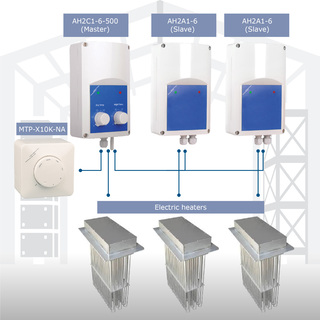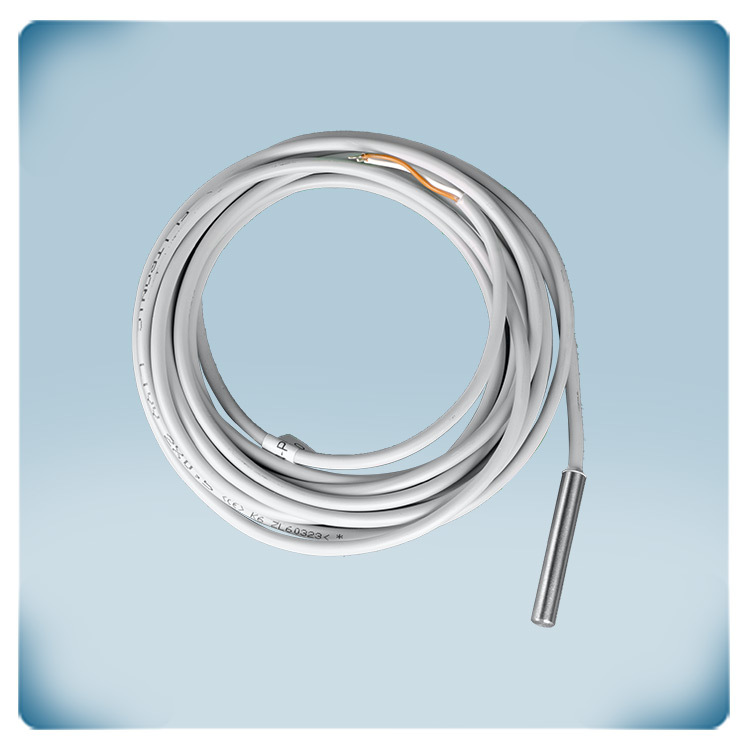EU declaration conformity
Electric heater controller | 6 kW
Product description
This controller is designed specifically for electric heating elements and provides precise control and efficient operation for both single-phase 230 VAC and two-phase 400 VAC electric heating elements, ensuring optimal heating performance.
For accurate temperature measurement, the controller offers the option to connect a PT500 temperature probe. This allows you to monitor and adjust the ambient temperature with precision, ensuring maximum comfort and energy efficiency.
The controller utilizes time-proportional control with TRIAC technology, enabling precise regulation of the heating element. This technology ensures efficient heating operation by modulating the power supplied to the heating element based on the desired temperature setpoint.
Adjusting the temperature setpoint is simple and convenient with the integrated potentiometer. Additionally, an optional external potentiometer can be connected, providing remote access to adjust the temperature setpoint from a convenient location.
The controller features two digital inputs to enhance control flexibility. One digital input allows for remote ON-OFF switching, enabling convenient control of the heating element from a separate device or system. The other digital input enables you to switch between day and night temperature setpoints, providing the versatility to adapt to different environmental conditions throughout the day.
With a maximum (resistive) load capacity of 3.2 kW for single-phase 230 VAC or 6 kW for two-phase 400 VAC, this controller can handle a wide range of heating requirements.
Documents
Additional specifications and description
Electric heating elements convert electricity into warm air. This warm air can be used to heat a room or a building. Controllers for electric heating elements work by monitoring the temperature of the environment and adjusting the power supplied to the heating element to maintain a desired temperature setpoint.
The controller utilizes a temperature sensor, such as a PT500 temperature probe, to measure the ambient temperature. The sensor is typically placed in the area where temperature control is desired.
The controller allows you to set the desired temperature using the integrated potentiometer. It employs a control algorithm to compare the measured temperature with the desired setpoint temperature. Based on this comparison, the controller determines whether heating is required or not.
If the measured temperature is lower than the setpoint temperature, the controller activates the heating element. It regulates the power supplied to the heating element to generate heat and raise the temperature.
The technology
The controller utilizes time-proportional control with TRIAC technology. This is a method used to regulate power to heating elements or other resistive loads based on the desired temperature setpoint. It involves modulating the power supplied to the load by controlling the duration of time the power is switched on during each cycle of the alternating current (AC) waveform.
TRIAC (Triode for Alternating Current) is a type of electronic switch that can control the flow of current in both directions in an AC circuit. It acts as a solid-state relay, allowing the controller to turn the power to the heating element on and off rapidly in a controlled manner.
In time-proportional control, the TRIAC is used to switch the power to the heating element on and off in cycles. The duration of time the power is switched on during each cycle is varied to achieve the desired temperature setpoint. For example, if the setpoint is lower than the current temperature, the power may be switched on for a shorter duration, reducing the overall power delivered to the heating element. Conversely, if the setpoint is higher, the power may be switched on for a longer duration to increase the power delivered.
Day-night temperature control
The requested day and night temperature can be adjusted via two potentiometers on the front cover. Via a digital input, the day or night regime can be selected. If necessary, an external potentiometer can be used to adjust the temperature setpoint remotely.

Temperature probe PT500
This controller requires a PT500 temperature probe to measure the ambient temperature. Sentera offers PT500 temperature probes in different enclosures.
Extra heating capacity
Electrical heaters up to 3,2 kW (230 VAC) or up to 6 kW (400 VAC) can be controlled. If necessary, extra heating capacity can be connected via an expansion module. The expansion or slave module can be connected via the output (0-10 V or 0-20 mA). The extra heaters are controlled synchronously.
Master or Slave
AH2C1 can operate both as a Master and a Slave device. Master and Slave modes are selected via Modbus holding register 13 or, in case you do not intend to use Modbus, via the DIP switches. Depending on the selected mode and the intended use, the controller needs to be connected to the external devices.
Solid enclosure
The enclosure is made of high-quality r-ABS VO (UL94) plastic. This material is flame extinguishing in case of fire, very tough and offers good protection against impacts. It offers an IP54 protection against ingress of moisture and dirt.







.webp)
.webp)
.webp)
.webp)
.webp)
.webp)



Remarks, reviews & ratings